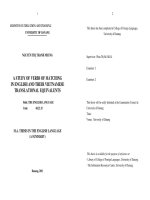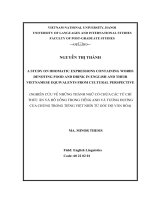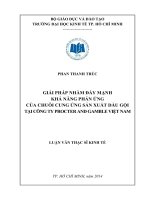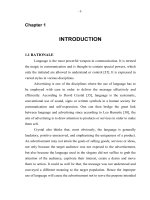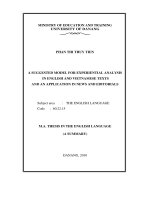Online advertising application in Procter and Gamble Vietnam
Bạn đang xem bản rút gọn của tài liệu. Xem và tải ngay bản đầy đủ của tài liệu tại đây (900.74 KB, 47 trang )
MINISTRY OF EDUCATION & TRAINING UNIVERSITEÙ LIBRE DE BRUXELLES
HO CHI MINH CITY OPEN UNIVERSITY SOLVAY BUSINESS SCHOOL
MBMM PROGRAM
Le Thi Thanh Huyen
“ONLINE ADVERTISING
APPLICATION IN PROCTER&GAMBLE VIETNAM”
FINAL PROJECT
MASTER IN BUSINESS & MARKETING MANAGEMENT
Tutor: Dr. Dang Ngoc Dai
Ho Chi Minh City
(2007)
ACKNOWLEDMENT
May I take this chance to thank many people for making this project
possible.
I would like to thank my tutor, Dr. Dang Ngoc Dai for his guidance and
support throughout the end-course project and to my mentor, Mr. Dau
Quang Phan for his encouragement advice and quick respond when I need
technical assistance.
My thanks also go to the professors who involving in lecturing for
supporting me in understanding my academic endeavor.
I would also like to thank Mr. Serge and Ms. Tran for strong coordination
and support throughout the course.
My special thanks are to Management Board of Vietnam and Belgium
program, especially, Mr. Bayen and Mr. Tran Anh Tuan for their strong
collaboration in developing this course.
TABLE OF CONTENT
Executive summary
Chapter 1: Introduction
Chapter 2: Online Advertising Overview
2.1 Internet characteristics
2.2 Internet comparison with other media
2.3 Online advertising formats
2.4 Online advertising trends in the world
2.5 Vietnam online advertising market context
2.5.1 Internet penetration
2.5.2 Online advertising trends in Vietnam
Chapter 3: Business Environment Analysis
3.1 Market analysis
3.1.1 Market context
3.1.2 Target audience
3.1.3 Advantages of online advertising
3.1.4 Competitor analysis
3.1.5 Case: Pepsi’s and Unilever’s online advertising campaigns
assessment
3.2 Internal analysis
3.2.1 P&G overview
3.2.2 The current advertising strategy of P&G
3.2.3 SWOT analysis
Chapter 4: Online Advertising Application in P&G Vietnam
4.1 Objectives
4.2 Online strategy and tactics
4.3 Online advertising development
Conclusion
Reference materials
Appendix
ABBRIVIATION
P&G Procter & Gamble
FMCG Fast Moving Consumer Goods
TNS Taylor Nelson Sofres
SMS Short Message Service
CRM Customer Relationship Management
HCMC Ho Chi Minh City
OOH Out-of-home
TVC Television Commercial
TOM Top of mind
TABLE AND CHART INDEX
Chart
Chart 1: Internet consumption (Share of voice)
Chart 2: Media consumption trend
Chart 3: Internet penetration in four key cities
Chart 4: Internet access frequency in four key cities
Chart 5: Internet surfer profile by Gender and Age group
Chart 6: Internet surfer profile by Education and Income
Chart 7: Internet advertising impact
Chart 8: Print advertising impact
Chart 9: TV advertising impact
Table
Table 1: Unilever’s spending proportion by media
Table 2: Effectiveness of Unilever’s online advertising campaigns
Table 3: P&G’s spending proportion by media
Table 4: Sample age distribution in HCMC
i
EXECUTIVE SUMMARY
Procter & Gamble (P&G) is one of leading FMCG companies in Vietnam
market. P&G is also the second player in Vietnam advertising market with total
spending (based on TNS data) at USD 17 million in 2006. In Vietnam, P&G only
uses traditional media that is TV, print and radio. TV is still the king but there is
a fact that people nowadays have a tendency to spend less on TV, print and radio
while spends more on internet. In addition, TV, print and radio traditionally
enable one way communication only while internet allows interactivity with
consumers. Internet seems to have more advantages than other current media.
However, Vietnam is just in the first stage of e-commerce and some companies
still consider internet as a traditional channel. Companies show their concern on
using online advertising tools and there is no research company studies the
effectiveness of online advertising.
For above reasons, there is a need to find out whether internet works effectively
and should and how P&G use internet as a new channel beside its current
channels.
To answer for above-mentioned questions, the project explores the following
matters:
- Vietnam advertising context which mentions online advertising trends in
Vietnam. Advantages of online advertising in terms of cost efficiency,
convenience and target audience. Online advertising effectiveness is
also measured by the attitude of internet users towards advertisements
on internet.
ii
- Case study: success of online advertising campaign of Unilever who
already aggressively use internet as a supporting tool in the last Lunar
New Year and Pepsi who currently uses internet as a main channel to do
promotion.
- Online advertising application in P&G Vietnam situation.
A research is carried out to support the project. However, because of limitation
in time and resource, just a small sample size is recruited. The data, therefore, do
not ensure a high fidelity.
Overall, internet has some advantages in comparison with other media which are
i) penetration rate is quite high and increasing; ii) people whom internet reaches
are young, well educated and have high income, iii) internet can convey more
information and get feedback of consumers quickly; iv) there is no limitation in
internet and the cost is relatively lower than other media. In addition, the online
advertising strategy of Unilever has a good result in terms of image, consumer’s
recall and business.
From that point, although current media such as TV, print and radio still show
their effectiveness, P&G should use internet as an additional channels to support
offline activities. With condition of Vietnam market which is in the beginning
period of e-commerce, P&G can use online advertising under the forms as
follows: website, banner ads and email. However, these forms should ensure the
attractiveness and innovation to stand out from the cluttered advertising
environment.
Page 1
Chapter 1
INTRODUCTION
Procter & Gamble (P&G) and Unilever are two market leaders in Vietnam
FMCG market. Unilever, therefore, becomes a big competitor of P&G. Their
products are in harsh competition in most of categories such as hair care, skin
care and laundry.
According to TNS, in 2006, Unilever spent USD 49 million on advertising of
which USD 42 million was on television. Beside key channel TV, Unilever also
uses Print, Radio, Internet and Out-of-home (OOH). At the end of last year, on
the occasion of Lunar new year (Tet holiday), the company launched a series of
campaigns focusing on internet. They use online communication as a backup to
offline communications. These activities are considered as a part of package to
reduce marketing communication budgets and at the same time, reaching a wider
audience.
Meanwhile, most of marketing activities of P&G are advertising on TV, Print
and OOH. These advertising media have used for many years, but recently there
is a need to locate new advertising media that are less costly, less cluttered and
potentially more effective than the established media.
Objectives of the project
The project studies the effectiveness of online advertising and considers the
possibilities of applying online advertising in P&G business.
Scope of the project
Page 2
The project tries to explore the effectiveness of online advertising in Vietnam
market towards FMCG products only.
Methodology
Besides data get from government and market research companies, data also get
from a research which is carried out to support the project. However, because of
limitation in time and resources, just a sample size is recruited which means the
high deviation in data.
Structure of the report
There are four main parts to this report
Part 1 gives the reason to choose this project, project’s objectives, scope and
methodology used to support the project.
Part 2 introduces some concepts, definition and overview of online advertising in
the world and in Vietnam market context.
Part 3 explores influential factors to online advertising application in P&G
Vietnam.
Part 4 examines the development of online communication in P&G business.
Page 3
Chapter 2
ONLINE ADVERTISING OVERVIEW
2.1 Internet characteristics - 2 I’s of internet
Individualization and interactivity is key features of internet and advertising on
internet. Individualization refers to the fact that the internet users can control
over the flow of information. Therefore, there is an ability to reach the consumer
thanks to advertisements and promotions related to them. Internet also enables a
two way communication among its users based on the information they perceived
as relevant. This allows marketers to establish and enhance relationship with
their customers. This is another feature of internet - interactivity.
2.2 Internet in comparison with other media
Each of major advertising media has a set of advantages and disadvantages. It
means no medium is perfect for all purposes and internet is not an exception.
Advantages
Basically, internet is an interactive medium. Millions of people around the world
have access to the internet. Thousands of marketers have used internet as a
prospective medium besides traditional media to promote their brand, create
brand awareness, influence attitudes and purchase intention, and driving sales.
One advantage of internet is while space and time within traditional media is
limited and cost increases along with increases in demand for space and time;
space in internet is unlimited, so advertisers can maintain at lower cost. In
Page 4
addition, internet is a medium which enables two-way communication with
customers while traditional media just provide one-way.
Disadvantages
However, internet’s interactive feature, on the other hand becomes
disadvantages. For traditional media, say, TV, they watch TV programs and
advertisements in a relaxing mood. Therefore, messages communicated by
advertisement on TV are more absorbable. While internet users are driven by
their purpose of obtain information, internet advertisements such as pop-ups,
banners represent an interruption and obstacles for them. For this reason, internet
advertisement lessens its effectiveness.
2.3 Online advertising formats
Online advertising are use of internet as advertising medium. There are many
types of online advertising as follows:
Website. Website for a brand is an invaluable advertising medium for conveying
much more information about the brand, its character and its promotional
offerings.
Banner ads. Banner ads are the dominant form of internet communication.
Banner ads use a link through to an advertiser’s chosen destination and therefore,
can act as a gateway to websites but also effective in their own right. There are
many kind of banners such as floating banner, trick banner, expanding banner
and so on.
Pop-up ads, Interstitials or Superstitals. Pop-ups are ads that appear in a
separate window while a selected web page is loading. Interstitials also appear in
the time when pages are being downloaded. However, unlike pop-ups,
Page 5
interstitials do not interrupt the users and users have less control over interstitials
because there is no exit option to stop or delete an interstitial.
Email. Advertising via email is extremely cost effective. In addition, email
communications are easily customized for different segments.
Besides, there are many types of online advertising such as video ad, search
engine, micro site and so on.
2.4 Online advertising trends in the world
Internet penetration
It’s estimated that about 15 billions of people get accesses to internet every day.
It would be a favorable condition for online advertising explode and become the
first in development trends in the current information technology world.
Internet today is the third only after TV and Radio in usage. A survey carried out
by SRI–Knowledge Networks in 2003 indicates that people now spend more time
Newspaper
4%
Internet
14%
Radio
27%
TV
52%
Magazine
3%
Chart 1: Internet consumption (Share of voice)
Source: SRI – Knowledge Networks, Media Scan Spring 2003
Page 6
with internet than with newspaper and magazine. Internet accounts for 14% of
total media consumption compared to 52% to TV and 27% to radio (see chart 1).
Online advertising trends
Credit Suisse First Boston (CSFB) estimated that online advertising turnover in
2006 is USD 16.6 billion and will be reach 33.8 billion in 2010. Budget for online
advertising just accounts for a small proportion in total spending (e.g. 2.6% in
Europe). However, the growth rate of online advertising is extremely high which
always maintains at the first compared with other traditional adverting tools.
ZenithOptimedia Research Company estimates that online advertising’s growth
rate is 21% in 2004 and tends to increase in the next coming years.
Online advertising company also gains a high growth rate. In the first quarter of
2005, Google gained a profit of USD 369 million out of USD 1.3 billion
turnovers, up 93% from the same period last year. This is the same for Yahoo
with USD 205 million out of 1.2 billion turnovers, up 55% in comparison with this
quarter in 2004.
2.5 Vietnam’s online advertising context
2.5.1 Internet penetration
After 10 years in Vietnam, internet gains some paces of development.
According to Vietnam Internet Centre (VNIC), there are currently 14 million of
people, accounting for 16% Vietnam population usually access internet. The
Vietnamese government has announced plans to increase the country’s internet
penetration to 35% by 2010, according to a report by news agency AFP.
However, internet penetration rate in 4 key cities Hochiminh, Hanoi, Danang and
Cantho, which are also main markets of P&G and Unilever, is higher. The
Page 7
average internet penetration of these 4 cities is 37%. Especially, in the first
priority city, HCM city, the proportion reaches over 45%. (See chart 3 in
Appendix 3)
About 12% of population in 4 cities gets access into internet almost every day.
The figure is higher in top two cities, say, about 15% for both HCM and Hanoi.
(See chart 4 in Appendix 3)
2.5.2 Online advertising trends in Vietnam
According to Vietnam Advertising Associates (VAA), Vietnam advertising
turnovers in 2006 is VND 12,000 billion and is estimated to reach 24,000 billion
in the next 15 years. The growth rate of advertising market is high, from 20% to
30% per year. However, Vietnam’s online advertising turnover Vietnam is quite
low. Total turnover of leading websites is about 64 billion, equivalent to 0.5%
total spending on advertising. They forecast internet advertising in Vietnam can
get a growth rate of 100% per year, and reach 600 billion of turnovers in 2010.
In 2006, online advertising market is apparently quite quiet. However, behind the
quiet, there are undercurrents which preparing for a new leap when online
advertising affirms its outstanding advantages efficiently supported by global
internet. Companies also include online advertising into their marketing strategy.
And some of e-commerce companies which formerly operated as head hunter
now expands to online advertising and considers it as a long term development
plan.
Page 8
Chapter 3
BUSINESS ENVIRONMENT ANALYSIS
3.1 Market analysis
3.1.1 Market context
Apart from banner, pop up and online video, almost there are no other forms of
online advertising in Vietnam’s websites. While in the meantime, there are a lot
of forms which entitle customers many choices besides banner hanging such as
online survey, rich media banner ads, in-game ads, and in-streaming ads and so
on. In the other hands, the main source of income of online advertising
companies is from searching services which is quite different from the Vietnam’s
companies. With these online advertising formats, charging and effectiveness,
there is a big gap between Vietnam’s and the world’s online advertising.
3.1.2 Target audience
According to Media Habit Survey of TNS conducted at the beginning of 2006,
about 54% internet surfer is male. Internet penetration is 41% among male and
32% among female. Especially, the youth makes up a major part in internet
population with 56% from 15 to 24 years old. (See chart 5 in Appendix 4). As per
data of the self conducted survey, most of internet users gain high education and
have high income. About 60% internet users are high educated (university
graduation and higher) and have high income (over USD 600 per month). (See
chart 6 in Appendix 4). Internet is really a good channel to reach men, women
with modern life style and teenage.
Page 9
In general, in 3 leading advertising tools, that is TV, newspaper and internet, TV
holds the first position, next is newspaper and internet. However, internet
recently has a trend to overcome newspaper because most of internet users are
high income, stable work, young, quite high education people who belongs to
high frequent shopping consumer segment.
3.1.3 Advantages of online advertising in Vietnam
Besides advantages of internet in general as mentioned in chapter one, online
advertising in Vietnam market also has the followings advantages:
Cost efficiency
Internet offers companies a new tool of advertising to reach target customer
more effectively. Normally, it costs tens of millions VND to post an
advertisement of full page in one issue of any newspaper. But with the same
amount of money, a logo linked to an advertising website will be hanged in
websites in 1 month.
It is relatively inexpensive to create a site. Domain name registration can cost
USD50, website design (50 pages) may cost USD3500 while hosting and
registering cost average out at around USD400, although this can vary widely.
The attractiveness is that the entry cost for all participants is the same and no one
website can gain a communication advantage over other as the share of voice
remains the same. In addition, a company, even with a high economic potential
seldom runs an advertising campaign on TV or print continuously in a long time,
but they can remain the campaign with the low cost for a long time on internet.
Convenience
Page 10
Online advertising is better than newspaper because it allows customers directly
go to websites by a click on logo or banner while with an advertisement on
newspaper, they have to remember the information, make the phone call or type
address to access to the company’s website to collect more information.
Besides, global scope, high interactivity, variety of format, online advertising is a
feasible choice for companies.
Reach efficiency
Internet seems to surpass print in the number of audience ad cost efficiency. The
average circulation of a publication is 300,000 issues. After deducting 50,000
issues unmarketable, there are 250,000 issues reaching the consumers. Among
these consumers, just a small percentage of consumers who read the publication
can afford to buy products advertised on it.
Meanwhile, it’s assured that about 1.5 million internet subscribers are of high
income.1 million people with quite high income compared with 250,000 readers
who belong to different income segment is really a big gap.
High response
According to the self-conducted research, about 8% of Vietnamese internet users
watch the internet advertisements as normal and 75% click to interesting ones.
The 17% remains’ attitudes are glancing at the advertisements briefly and
moving on and do not pay attention. (See chart 7 in appendix 5)
These figures seems to be less positive than consumers’ reactions against
advertisements on print and TV (30% readers and 45% TV viewer watch/read
advertisement as normal). However, internet advertising shows more attractive
than others because of high response from internet users. Advertisements on
Page 11
internet under forms of banners, logo or popup not only act as normal
advertisements, but also attract internet users to visit our websites.
3.1.4 Competitor analysis
Unilever overview
Unilever is also a multination FMCG company which presents in 150 countries in
the world.
In Vietnam market, Unilever is the key competitor of P&G with rival products in
the same categories such as hair care, skin care, oral care and laundry (detergent
and fabric conditioner). Besides these categories, Unilever also develops food
and drink category.
While P&G is famous for product’s quality, Unilever stands out for innovative
and adapted in communication with Vietnam market.
Unilever’s advertising strategy
Table 1: Unilever's spending proportion by media
Total spend
Spend proportion
Media
2005
2006
Media
2005
2006
Total
45,203
60,495
Total
100
100
TV
39,320
45,739
TV
87
76
2,675
3,243
6
5
Radio
44
19
Radio
0
0
OOH*
3,164
9,074
OOH*
7
15
Internet*
0
2,420
Internet*
0
4
Source: TNS Media Vietnam - Ads Track
(*): Estimated data on the key ads positions
Total spending of spending of Unilever in 2006 is USD 60 million. TV is still the
dominant channel of Unilever, accounting for 76% of total budget. However, in
Page 12
2006, the proportion of TV decreases from 87% to 76% while investment on
OOH increases. Remarkably, the company starts to use internet as new channel
to reach consumers. It’s estimated that spending on internet makes up 5% of total
spending. (See table 1)
The end of year when the biggest holiday – Tet (Lunar New Year) take places is
the golden time for advertisers. TV is the most popular channel to reach
consumer. However, when advertisers flock into TV, your message might be
submerged in a mass of messages of the same of different products. In addition,
space and time of TV advertising is limited. At that time, it is very difficult to
reach the target customer in the cluttered TV environment.
Out of home (OOH) ads is another choice. But following trends of the world
which traditional media goes interactive, internet is a smart choice.
At the end of 2006, Unilever launched a series of internet campaign for almost of
its products such as Laundry (OMO detergent, COMFORT fabric conditioner),
Haircare products (SUNSILK, DOVE, CLEAR), FOOD (KNORR fish source) as
the support to offline activities.
3.1.5 Case: Pepsi’s and Unilever’s online advertising campaigns assessment
3.1.5.1 Pepsi’s campaign: promotion online
Concept
The campaign is promotion online. Other media such as TV, print, OOH is to
support online campaign.
Consumers drink Pepsi, get the code under the crown and enter into the website
to get bank account. From this account, they can accumulate points from Pepsi
Page 13
consumption or from interactive programs/ contest in the site to get win prizes.
The prizes are granted every hour (8 hours per day).
Objective
Objective of Pepsi online campaign is to build a digital-online interactive
playground for teen consumers, to interact between the brand and the target.
Campaign execution
Step 1: create awareness by advertising on traditional media (TV, daily
newspaper, leaflets and posters) which mention the website address. In addition,
banner and pop up logo are also hanged on popular music and news websites
which directly link to the website.
Step 2: build traffic by communicating the main concept of campaign: drink Pepsi
or win contests on website to accumulate the points and emphasizing that winner
list are updated every hour. The website also offers
- Free music and pictures of football idols, music idols, free ringtone
downloading, game online.
- Teen news.
- Chat with Pepsi’s celebrities.
Step 3: interact with consumers by some activation activities
- Forum by topics.
- Pepsi’s can designing
- Blog designing, singing/karaoke contest, style-up contest, music
composition contest.
Result
Page 14
After 1 month from launched, about 1.2 million website accesses (website
www.pepsiworld.com.vn) are counted. Promotion joined from website is 25%
compared with 75% of traditional development. Besides saving cost, the
campaign enables Pepsi a way to better communicate, be more interactive with
consumers and especially, makes Pepsi differentiate from other beverage brands.
3.1.5.2 Unilever’s campaign: online to support offline activities
Objectives
Unilever uses online activities as a channel to communicate with consumers
besides offline activities.
Campaign execution
Step 1: create awareness. Although online is just a supporting channel to offline
activities, concept of online is the same as offline. Consumers can get the
website address on print ad or click on banners. which are easily to recognized
because of the same concept and theme with print ads, TVCs and billboards.
When launching a website, Unilever’s brands hang banners on popular websites
such as news local websites, music local websites and especially they fully cover
Yahoo services from Yahoo Messenger (bottom banner), Yahoo Mail (top
banner in main page and Inbox), Yahoo Insiders.
Noticeably, banners of Unilever’s brand are designed under the same concept
and theme with print ads, TVCs and billboards which helps internet users easily
recognize and attracts them to click in.
Step 2: website traffic building.
Page 15
Most of Unilever’s brands have websites. Websites which act as a support to
offline activities are temporary. The theme and leitmotif of websites are subject
to season and specific period.
These websites offer
- News related to website’s concept or offline event.
- Free SMS, e-cards
- Games online, free download music, ring tone, PC and mobile wallpaper.
- Some tips: hair caring tips (for Dove), clothe care (for Comfort) and
cookery introduction.
Step 3: Interaction: these websites offer interactive activities with consumers
such as
- Product and promotion information, consultant on product using,
advertising video clips which also posted on TV.
- Community activities: blog, contest (singing contest).
Result
In general, advertising campaign of Unilever gains good result which shows high
brand awareness and increase in market share for most of brands. Especially, as
per a survey conducted by AC Nielsen in Mar, Omo and Comfort are in top 5
favorite brands. This result also demonstrates the contribution of online
advertising in the total campaign. The high internet exposure partly makes brand
awareness increase. In addition, internet enables brands to communicate with
consumer more effectively which builds TOM (Top of mind) and also drive
market share growth.
Page 16
The result of the campaigns is showed in the table followed
Table 2 : Effectiveness of Unilever’s online advertising campaigns
% of internet users (age of 15 and more)
Band
Awareness
*
Internet
exposure*
Website
daily
reach**
Website
page
view/day**
Business
Result
(share)
OMO - Promotion on TET (www.omotet.com)
82%
44%
7%
1.0
+1.9%
COMFORT - The fabric world (www.thegioivai.com)
82%
51%
5%
1.4
+0.6%
CLEAR - Vietnam Idol Contest (www.vietnamidol.com.vn)
80%
42%
5%
3.7
+1.4%
DOVE - Product promotion (www.dovevietnam.com)
N/A
N/A
2%
2.9
+1.2%
(*) Self conducted research
(**) web www.alexa.com
3.2 Internal analysis
3.2.1 P&G overview
History
Procter & Gamble was founded by William Procter and James Gamble in
Cincinnati in 1837. The company handles 300 brands in 180 countries.
P&G Vietnam which was established in 1995 is a joint venture between P&G and
a Vietnamese company with the capital structure of 93% vs. 7%. The company
has one manufacturing plant in an adjacent province to HCMC and recruits more
than 250 people. Nowadays, P&G’s products under 20 brands are sold in more
than 40,000 stores nationwide.
Vision
Page 17
1. Be the leading Consumer Goods Company in Vietnam for reputation,
volume and profit.
2. Have the number one brand in each category, loved by Vietnamese
consumers, due to the superior performance and value of products.
Products & Target audience
In Vietnam market, P&G supplies a wide range of products from personal care
(hair care, beauty care, body care, tooth brush, razor) to household products
(detergent and fabric conditioner). P&G is inherently famous for products of high
quality and its strategy is to position its products at premium level.
The main target audience of P&G’s brands is female of age over 15 and most of
them belong to upper classes. Its markets focus on big cities, especially top three
cities Hochiminh, Hanoi and Cantho.
3.2.2 The current advertising strategy of P&G
Table 3: P&G's spend proportion by media
Total spend
Spend proportion
Media
2005
2006
Media
2005
2006
Total
17,331
22,075
Total
100
100
TV
17,156
21,708
TV
99
98
175
363
1
2
Radio
0
4
Radio
0
0
OOH
OOH
Internet
Internet
Source: TNS Media Vietnam - Ads Track
P&G does advertising on TV, Print and Radio only. The company uses TV as
dominant channel to reach consumers with investment of 98% of total spending.
P&G spends a little on Print and Radio. While the main competitor – Unilever
